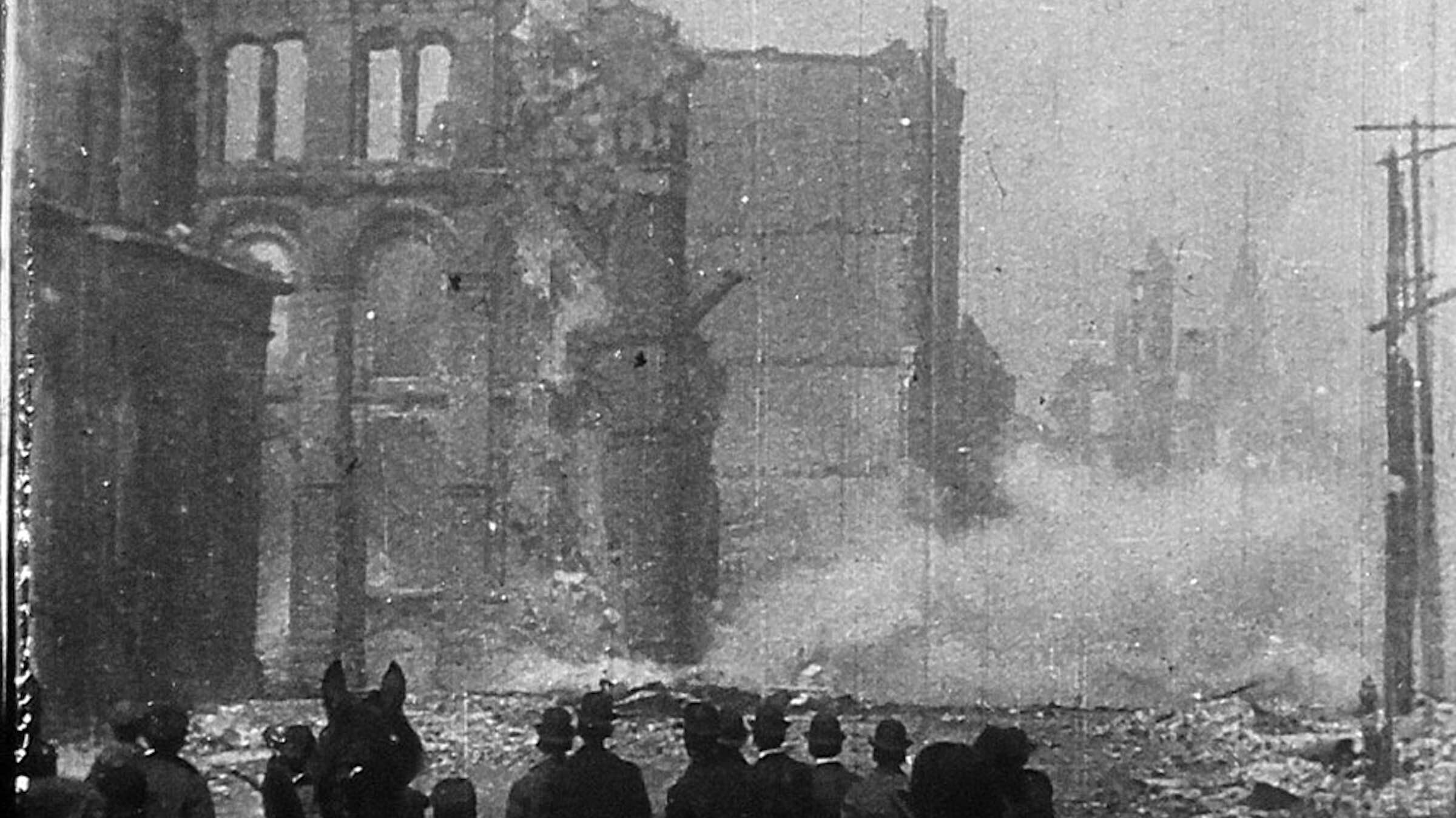A Collection of San Francisco Shorts
A TRIP DOWN MARKET STREET (filmed April 14, 2006)
Producer Miles Brothers Cinematographer Harry J. Miles Print Source The Library of Congress
SAN FRANCISCO EARTHQUAKE AND FIRE, APRIL 18, 1906
Producer Unknown Cinematographer Unknown Lubin Film Company Cameraman Print Source The Library of Congress
SCENES IN SAN FRANCISCO [NO. 1] (filmed May 9, 1906)
Producer American Mutoscope & Biograph Company Cinematographer Otis M. Gove Print Source The Library of Congress
MABEL AND FATTY VIEWING THE WORLD’S FAIR AT SAN FRANCISCO (1915)
Director Roscoe Arbuckle
Cast Roscoe “Fatty” Arbuckle, Mabel Normand, Mayor James Rolph Jr., Mme. Ernestine Schumann-Heick Producer Keystone Film Company Print Source The Library of Congress
TRIUMPH OVER DISASTER (filmed with a 1922 hand-cranked Bell & Howell 2709 35mm movie camera at the 1906 Earthquake Centennial Commemoration at Lotta’s Fountain on April 18, 2006)
Producer George C. Hall Cinematographer L Sprague Anderson Editor David Kiehn Print Source Niles Essanay Film Company
The April 18, 1906 earthquake changed the fortunes of many businesses, including the movie industry. Many nickelodeon theaters in the city were destroyed, temporarily slowing the growth of this new kind of entertainment. The first movie studio on the West Coast, built and operated by the Miles brothers, was also destroyed, debilitating San Francisco as a film production center and forever changing the industry.
The Miles Brothers facility was simply the latest link in San Francisco’s connection to the film business. Eadweard Muybridge had presented his “illustrated Photographs in Motion” at the San Francisco Art Association’s exhibition hall on May 4, 1880, to an audience that paid to see projected moving images for the first time. The demonstration inspired Thomas Edison to consult Muybridge before taking the next step in the evolution of motion pictures by recording photographic images on a strip of celluloid, rather than glass plates as Muybridge had done. The Edison laboratory in New Jersey produced a viewing device called the Kinetoscope for showing their films to the public, and on June 1, 1894 the first Edison machines west of Chicago were installed at Peter Bacigalupi’s San Francisco establishment in the Chronicle Building at Market and Kearny. After film projection was invented, William Furst opened the Cineograph movie theater at 747 Market Street in 1897.
In those early days, films were sold outright to theaters, but it wasn’t until exhibitors could rent films that theaters became a profitable business. One of the first companies to establish a film rental exchange office was Miles Brothers. Harry, Herbert, Earle and Joe Miles set up shop in the spring of 1903, importing films from Europe and buying from the five film producers then in the United States. The Miles Brothers soon established a national reputation, expanding to New York later that year and becoming the first film exchange company to operate from coast to coast.
When Miles Brothers opened an office in the American Mutoscope and Biograph Company building in New York, they produced a few films in San Francisco, copyrighted by Biograph. In 1905, the Miles Brothers moved the New York office across the street from Biograph, distancing themselves from that organization, to produce films on their own. That year they shot exclusive footage of the Nelson-Britt championship prize fight in Colma.
In 1906, Miles Brothers built a studio at 1139 Market Street in San Francisco to produce narrative films. That spring, they finished two nonfiction movies for the popular Hale’s tours theaters: “Climbing Mt. Tamalpais” (copyrighted April 21 as “A Trip Down Mt. Tamalpais”) and “A Trip Through Market Street” (known today as “A Trip Down Market Street”). The Market Street film, shot on April 14, was filmed on a cable car traveling from Eighth Street toward the Ferry Building. It provided a remarkable record of a moment in time – San Francisco four days before the disaster. Harry and Joe Miles left the city with their film footage on April 17 but heard of the tragedy en route by train to New York, and turned back with their equipment, sending the Market Street footage on to New York. Although the Miles Brothers studio survived the quake, it burned in the fire. The company set up a temporary office in Earle’s home at 790 Turk Street and during the next few weeks shot film of ruins, refugees and the beginnings of reconstruction. They vowed to rebuild their studio, but never did, and San Francisco’s early role in the film industry faded from memory.
Miles Brothers continued to operate, but the business changed in December 1908 when Edison formed the Motion Picture Patents Company with film producers Biograph, Selig, Lubin, Essanay, Kalem, Vitagraph, Pathé and Méliès. The Patents Company tried to force independent film producers and film exchanges out of business, so it could control both production and distribution. They succeeded at first, and the Miles Brothers New York office was forced to close. Herbert Miles became a fierce opponent of the Patents Company, partnering with such like-minded businessmen as Carl Laemmle and William Fox (later the founders of Universal and Fox Film, respectively) to establish independent production companies and distributors. Joe Miles eventually founded a film storage company. Earle Miles ran the San Francisco office as an industrial film producer and non-theatrical distributor. Harry Miles, the oldest brother, did not live to carry on the fight. Suffering from insomnia and a series of epileptic fits that forced him to withdraw from the business, he killed himself in January, 1908 by jumping from the seventh floor of his apartment building.
Presented at SFSFF 2006 with live music by Michael Mortilla

